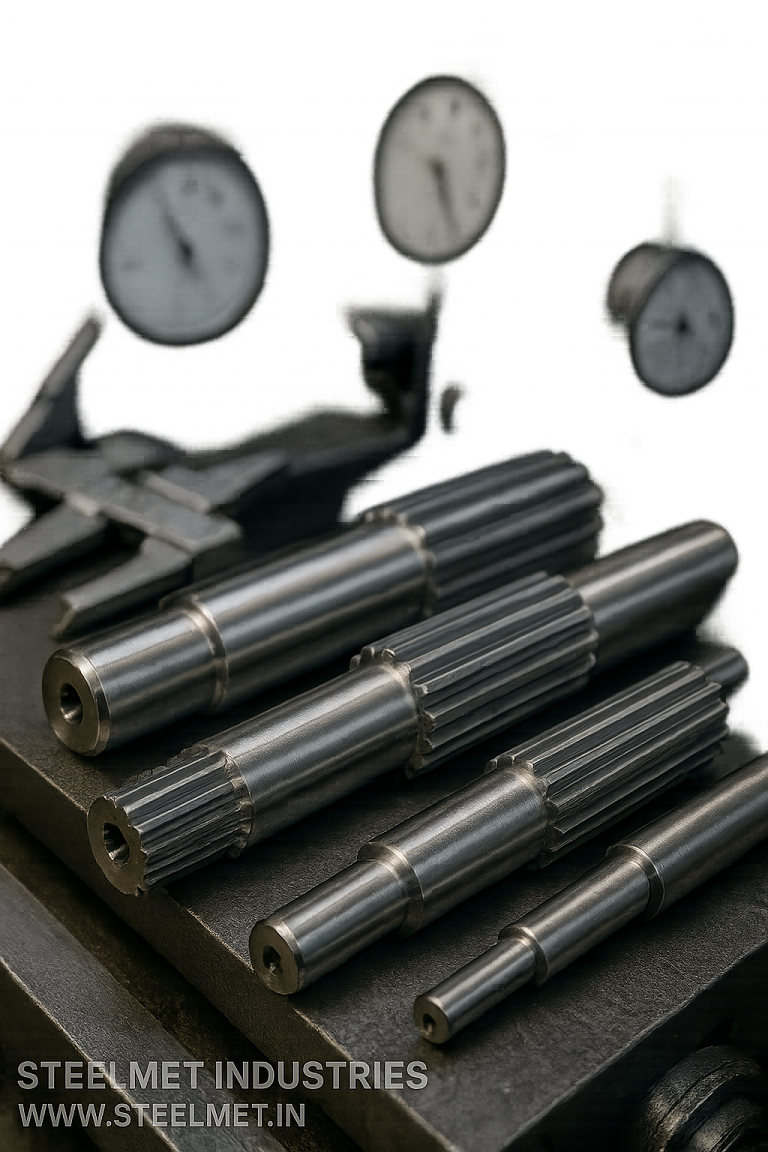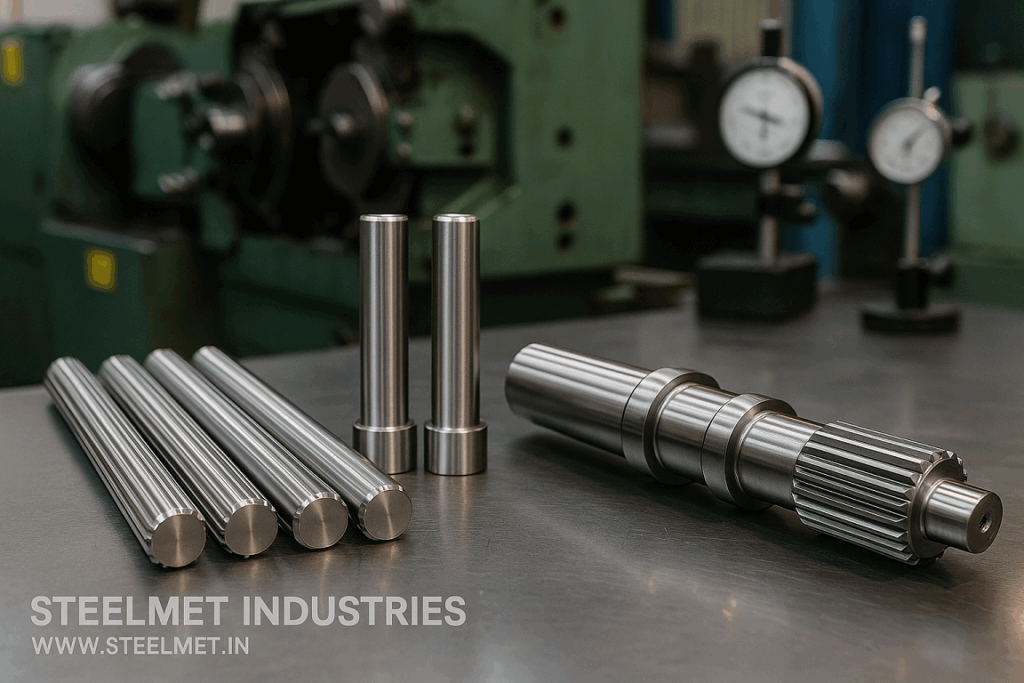Bright Steel Bars for Tooling, Shafts & Power Transmission
Power transmission and tooling components require excellent dimensional control, concentricity and metallurgical predictability. Bright steel bars deliver tight diameters, low runout and clean surfaces that reduce machining, improve balance and enable reliable heat-treatment — critical for gears, splines, shafts, couplings, mandrels and precision tool components that transmit torque or support rotating assemblies.

Bright bars prepared for spline rolling, gear shaft turning and mandrel finishing — ready for heat treatment and assembly.
Primary Applications
- Transmission shafts, gearbox input/output and countershafts
- Splined shafts, keyed shafts and spline rolling blanks
- Gear blanks, mandrels, arbors and precision tooling cores
- Couplings, shrink-fit hubs and interference-fit components
- Roller shafts, timing shafts and high-speed spindles
- Spline broaches, forming tools and die mandrels
Component Groups & Child Pages
Transmission Shafts & Countershafts
Shafts used in gearboxes require exceptional straightness and metallurgical uniformity to sustain torsional loads and permit accurate gear alignment. Bright bars reduce correction grinding and enable consistent spline fits.
Splined & Keyed Shafts
Splined shafts and spline blanks need materials that hold dimensional tolerances after spline rolling or machining, with appropriate case or surface treatments to resist wear while leaving a tough core.
Gears, Mandrels & Tooling Cores
Tooling cores, mandrels and small gear blanks benefit from bright-bar starting material for reduced machining allowance, improved concentricity and predictable heat-treatment behaviour.
Couplings, Hubs & Interference Fits
Interference-fit components require precise ODs and controlled metallurgical response to tempering and shrink-fit assembly; bright bars enable consistent assembly fits and minimal rework.
Why bright bars are preferred for tooling & power transmission
- Low runout and stable straightness reduce dynamic imbalance and gear misalignment.
- Predictable diameter allows controlled spline rolling, thread rolling and interference-assembly processes.
- Cleaner steel and consistent microstructure reduce the risk of crack initiation under cyclic torsion.
- Reduced machining allowance lowers cycle time and tool costs for high-precision components.
- Better surface finish improves mating contact in couplings and reduces fretting fatigue.
Real-world use case
Example: A gearbox supplier switching to EN19 bright-bar splined blanks reduced spline roll failures and post-heat-treatment grinding by standardising on bars with tighter concentricity and known hardenability. As a result, throughput increased and warranty returns for spline wear dropped substantially.
Quick decision pointers
- For splines and mating surfaces: consider 20MnCr5 for carburizing or EN19 for through-hardened splines depending on load and service conditions.
- For high-torque shafts: EN19/4140 or EN24/4340 are typical — specify Q&T and straightness tolerances.
- For mandrels and tooling cores: choose EN1A/12L14 for machined cores where high surface finish and quick machining are priorities; use EN24 where toughness is essential.
- For shrink-fit couplings: specify precise OD tolerances and Q&T cycles to control interference assembly results.
Failure-prevention and quality notes
- Define residual stress limits where spline rolling or cold forming is used — improper control causes distortion during heat treatment.
- Specify post-heat-treatment straightness and runout for long shafts to prevent balance or gear-mesh issues.
- For carburized splines, define case depth and core properties to avoid spalling under cyclic load.
- Include metallurgical cleanliness requirements (inclusion size/volume) for fatigue-critical shafts.
Standards & Equivalents (Table 1)
| IS | BS970 | AISI / SAE | DIN / EN | JIS | GOST | GB |
|---|---|---|---|---|---|---|
| C45 | EN8 | 1045 | C45E / 1.1191 | S45C | 45 | 45# |
| EN19 | 708M40 | 4140 | 42CrMo4 / 1.7225 | SCM440 | 40Х | 42CrMo |
| EN24 | 817M40 | 4340 | 34CrNiMo6 / 1.6582 | SNCM447 | 40ХН2МА | 34CrNiMo6 |
| 20MnCr5 | 655M20 | — | 20MnCr5 / 1.7147 | SCM420H | 20ХГ | 20CrMn |
| EN1A / EN1AL | 230M07 | 12L14 | 11SMnPb30 | SUM22 | 10ЮТ | Y12Pb |
| EN31 | 070M55 | 52100 | 1.3505 | SUJ2 | ШХ15 | GCr15 |
Grade Selection, Performance & Heat Treatment (Table 2)
| Grade | Typical Application in Tooling & Power Transmission | Performance Indicators | Typical Heat Treatment Route |
|---|---|---|---|
| EN19 (4140 / 42CrMo4) | Preferred for medium-to-high torque shafts, splined shafts and gearbox components where toughness and predictable Q&T response are required. | Machinability: Medium | Hardenability: Good | Wear Resistance: High | Fatigue Strength: High | Quench & Temper (Q&T); induction hardening for local wear zones; tempering to specified impact properties. |
| 20MnCr5 (case-hardening) | Common choice for splined shafts and gear mating surfaces that require a wear-resistant case and a tough core to resist fatigue and impact. | Machinability: Medium | Hardenability: Low (for case) | Wear Resistance: High (after case) | Fatigue Strength: High (core) | Carburize to required case depth (typ. 0.6–1.5 mm) followed by quench & temper; control case profile for spline roots. |
| EN24 (4340 / 34CrNiMo6) | Used for heavy-duty transmission shafts, mandrels and high-impact tooling that require deep hardenability and exceptional fatigue life. | Machinability: Medium/Low | Hardenability: Excellent | Wear Resistance: Very High | Fatigue Strength: Very High | Quench & Temper (Q&T); calibrated temper cycles; possible cryogenic treatment for very high fatigue applications. |
| EN1A / EN1AL (12L14) | Used for tooling cores, mandrels and machined fixtures where excellent surface finish and rapid machining are required and high strength is not primary. | Machinability: High | Hardenability: Low | Wear Resistance: Low | Fatigue Strength: Low/Moderate | Supplied as-drawn; typically used in the machined/finished condition; stress relief where required. |
| EN31 / 52100 | Selected for precision roller shafts and bearing-related tooling where high contact fatigue resistance is necessary. | Machinability: Low | Hardenability: Excellent | Wear Resistance: Very High | Fatigue Strength: Very High | Through-hardening and tempering; bearing-grade heat-treatment cycles or austempering where needed. |
Inspection & manufacturing checklist
- Specify straightness and runout limits before and after heat treatment for all long shafts and mandrels.
- Define case depth profile and hardness at spline roots to prevent premature flank failure.
- Request inclusion cleanliness and microstructure certificates for fatigue-critical transmission shafts.
- Prescribe post-heat-treatment balancing and finishing protocols for spindles and high-speed shafts.
Frequently Asked Questions
Which grade is best for splined shafts that are carburized?
20MnCr5 is typically specified for carburized splines because it provides a hard, wear-resistant case and a ductile, tough core; define case depth and core hardness in the drawing.
Can EN19 be used for both splines and through-hardened shafts?
Yes. EN19 (4140) is versatile — suitable for through-hardened applications after Q&T and for components where induction or surface hardening is used for wear zones.
How should I specify tolerance for spline rolling blanks?
Provide OD and concentricity tolerances plus cold-forming allowance for spline rolling. Specify pitch-diameter allowances and final machining or grinding requirements if any.
Contact for Tooling & Power Transmission Requirements
For transmission shafts, splined blanks, mandrels, tooling cores or long-term bright bar supply for power-transmission applications:
Related: All bright bar application pages — Splined Shafts — Industrial Machinery Components

